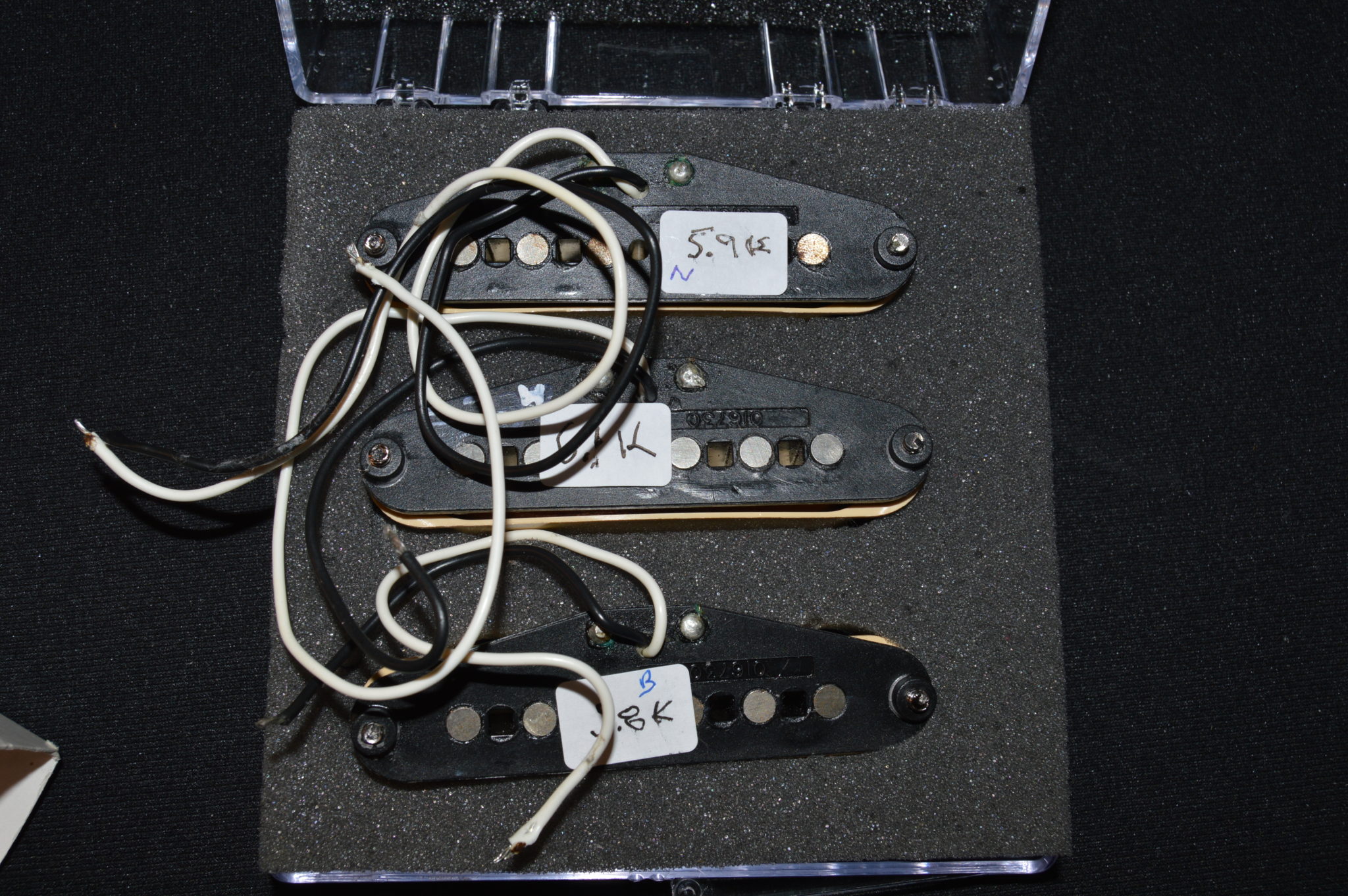FIGURING OUT PICKUPS
A great place to start is here: Fender Pickup Check List Fender typically has no “set” look for their pickups and often no number scheme or another unique identifier written on the pickup itself, usually the number of the pickup represents some or all the SKU when it does exist, but not always are all the numbers written or even written on them at all. The best way to identify them is often by looks and measurements combined. That said, some pickups, like the noiseless ones, are very easy to identify other can be dog gone hard. Bottoms, Wires and such make it a complete detective project at times because Fender would use whatever pickups they had on guitars in some cases so an MIM could show up with higher end pickups, or test runs, etc.Big Picture Info
- Don’t be fooled – The “Number” on the back of the pickup is usually a middle number in the actually part number or part of the part number, and this may change over time for the same model of pickup. Sometimes it’s rock solid so examine with caution.
- The number that is “molded” into the plastic is a BOBBIN NUMBER and is used over and over in different pickups. That just the plastic part number and is worthless for identifying pickups.
- The resistance values are approx. and can vary up to 10% in some cases or even more. The DCR are a guideline, not an absolute but in some cases they are very close.
- Pay attention to the stock wires used.
- Pay attention to the staggering on the poles.
- DCR is only PART of the sonic equation!!
REAL MEASUREMENTS (new page in development)
Last Page Update:2025.03.14
AMERICAN STANDARD
Not the same as American Special and American Performer (2018-2020) but in the same production “line”. In fact, many base US Fender Stratocasters Models to come from the same line (I got a American Special that the neck said Highway 1 Line straight from fender). The American Standard pickups are rather tricky because they changed over the years but the standard had many versions. They even had Fat 50s (see my custom shop, retail page) during the 2000s They do have some very common features that are very identifiable. The delta version has screws in the bridge pickup which mildly changed it’s characteristics. The “Standard” US Stratocasters became the Performer and used different pickups (Yosemite). They changed to Fat 50’s for a few years before the performer came out.
Typical measurements up until 2012 was values about 5.8K to 6.1K (except for the Bridge which was around 7K after 1997)
Note: You may find these on older Squier Classsic Vibe 50’s Strats
ORIGINAL VERSION: (Found on the power house MIM Strat also) Started Roughly about 1986
- Blue and White wires, WHITE is hot (Finish)
- No Stagger
- No Bevel
- Measurements change slightly through the years
- One Set: Measurements: 6.04K ,6.05K 6.06K
- 2.8H (all 3)
- 187pf Cap measurement @ 100Khz
- Black Bottom, plastic covered wire
- Used TBX Control (mid/bridge)
Version 2 (Roughly about the 1997 to 2007)
Highly identifiable by their Blue/Red/Yellow wiring (yellow on BRIDGE not the usual Middle)
- WIRES: Blue/Black (neck) – Red/Black (middle) – Yellow/Black (bridge)
-
Numbers: (UP TO 2007) 56205 (neck), 56206 (middle),56207 (bridge) — The official Fender document lists them as 0056205000, 0056206000 and 0056207000. (The left handed versions are the same but are 56707 (for example))
- NOT all of them have numbers on the bottom.
- COLORS:
- Up to 2007: Blue (neck), Red (Middle), Yellow (Bridge) – (WHITE START) – Some Bridge pickups have screws in them to change the mag field.
- After 2007: Blue (neck), Red (Middle), Yellow (Bridge) – (BLACK START)
- Staggered: No
- Bevel: No
- Middle RWRP: Yes
- Delta Tone system using No Load Pot
- MEASUREMENTS
- Bridge: 7.3K (has screws in it)
- Middle: 5.84K
- Neck: 5.8K
2012+
- Used Fat 50’s pickups
DELTA VERSION:
Approx 1997 Fender introduced the “Delta Tone” system. It’s notable by the bridge pickup has screws in it and is supposed to be higher output (via likely a change in the magnetic field response). They removed the TBX that was used before that and started using the no load tone control configuration. The 2nd tone controlled Mid and Bridge.
ORIGINAL VERSION – First Series – (NOTE: The dummy coil on the top came with the Power House Stratocaster (MIM)
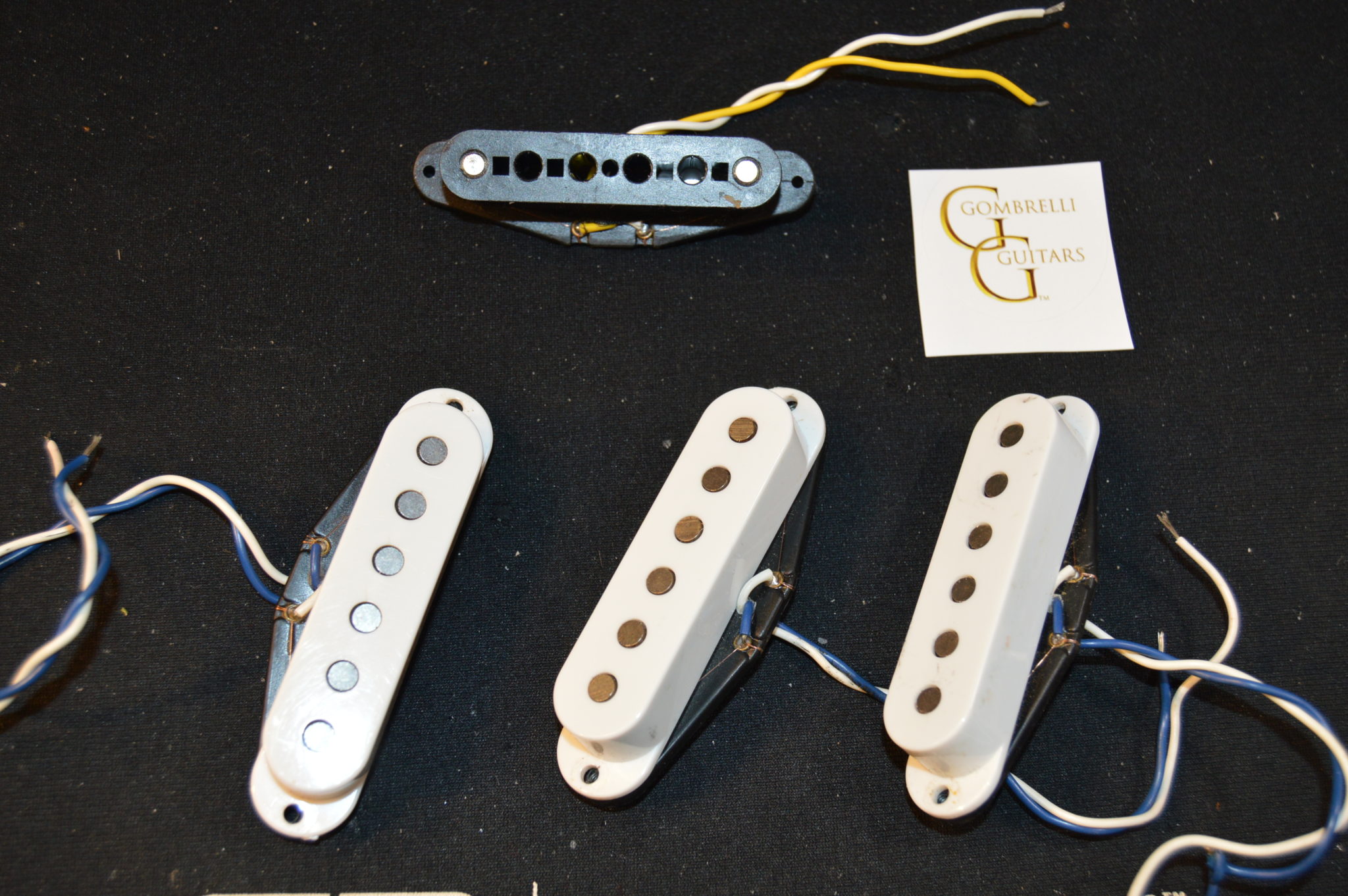
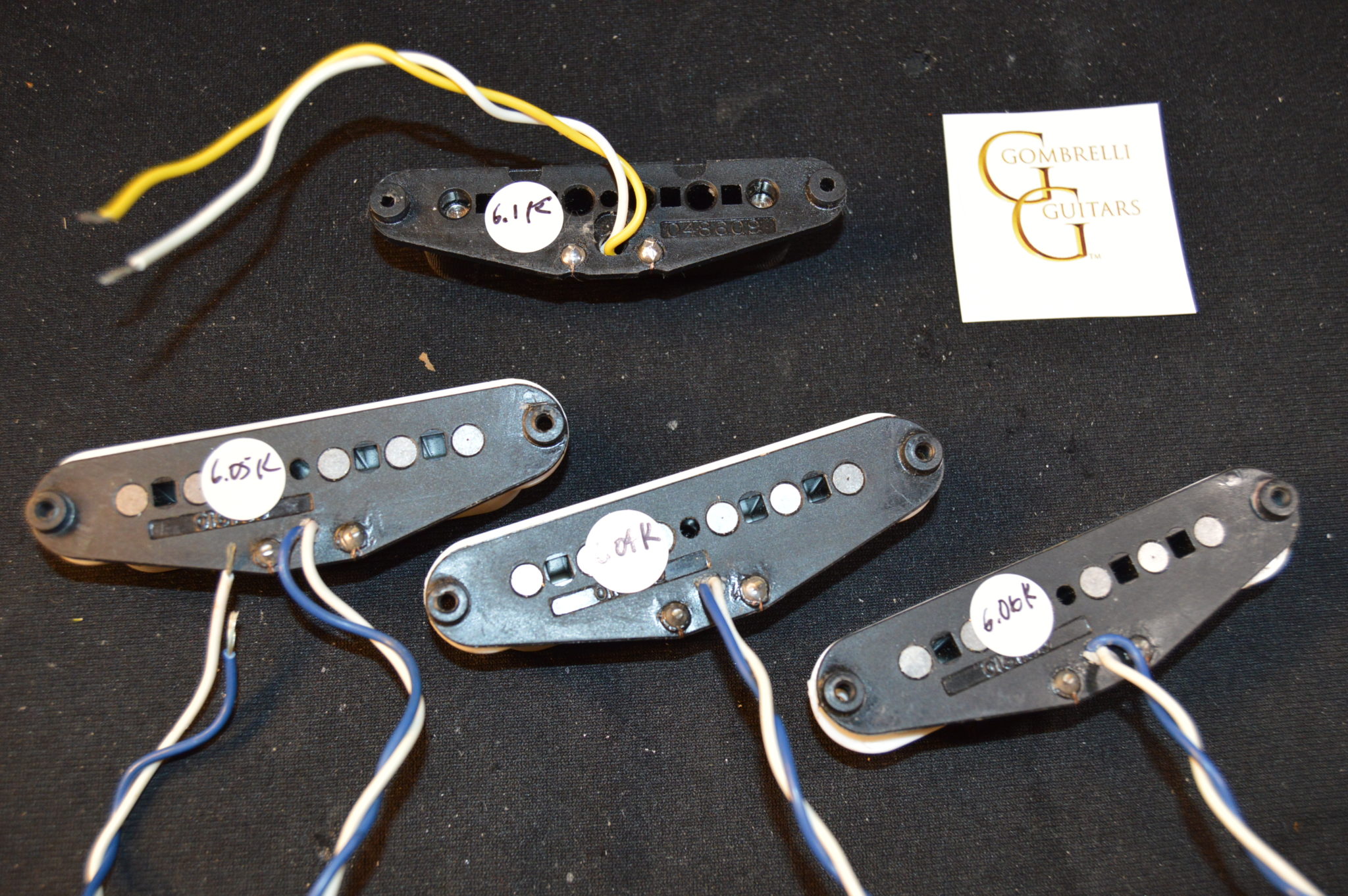
2nd versions are modified Tex Mex pickups.
Special Features: Some Bridge pickups have SCREWS in them and called the DELTA. It was used in conjunction with the TBX control.
NOTE: the BLUE RED YELLOW wiring and 205, 206, 207 which is DEFINATELY an American Standard Strat Pickup set.
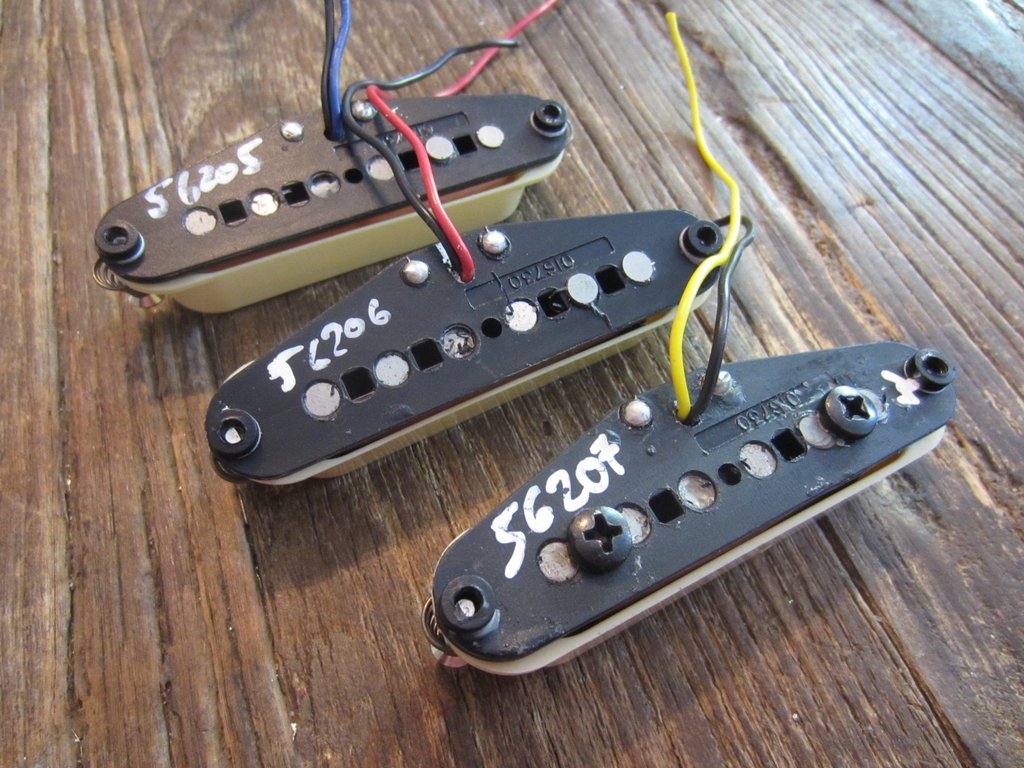

NOTE: The pickup bobbin is NOT a good identifier because Fender used that bobbin on many different pickups.
3rd revision (my term) used FAT 50’s – See the specifications for Fat 50s
HIGHWAY 1 (2001-2005) AKA 70ishs
Last Update: 2023.08.16
Highway 1 has had different pickups through the years, the early one had lower value pickups that are wired from finish to start instead of start to finish!! Often they are still connected with white “HOT” when they are actually “Black” Hot. The later ones are start to finish as expected not sure which year this changed. There is no RWRP and all poles are North.
The wires are all Black and White. There are NO identifiable marks on them except the typical bobbin number. The poles are FLAT (not beveled) and Staggered. More vintage tone than the later ones with lower output.
These pickups are another one of those “unseen hero’s” in Fender pickups. They also showed up with a screw in the bridge as DELTA pickups on AM Standard Strats before they switched to Fat 50s.
- Stagger: Yes
- Beveled: No
- Magnet: Alnico 3
- Pole Polarity: All North (NO RWRP)
- Wires: Black and White (with White as the start – ie: Black is “Hot”) Plastic Wire
- DCR: Early ones have a much lower DCR the later ones are hot wound.
- Historical Mimic: These are designed to match up with 1954-55 Alnico 3 Pickups.
- Sonic Comment: Mellower than Alnico 5 pickups
- Other Measurements
- 1st original Real Measurement: (see picture) (2003) – (Neck: 5.8k) (Middle – 5.8K) (Bridge 6.1K) (no inductance measured)
- Measurements – Tight Q 2.2 to 2.6Q
- Used Set 1: (verified)
- Bridge: 6K
- 2.17H @120Hz, 2.67H @1Khz — 2.42H Mean
- Middle: 5.8K
- 2.1H @120hz, 2.61H @1Khz — 2.355 Mean
- Neck: 5.8K
- 2.17H@120hz, 2.64H @1khz — 2.41 Mean
- Bridge: 6K
- Used Set 1: (verified)
- These were never sold in a retail package.
- These have a more vintage tone
- Note: These showed up later as Classic 70s pickups after 2006
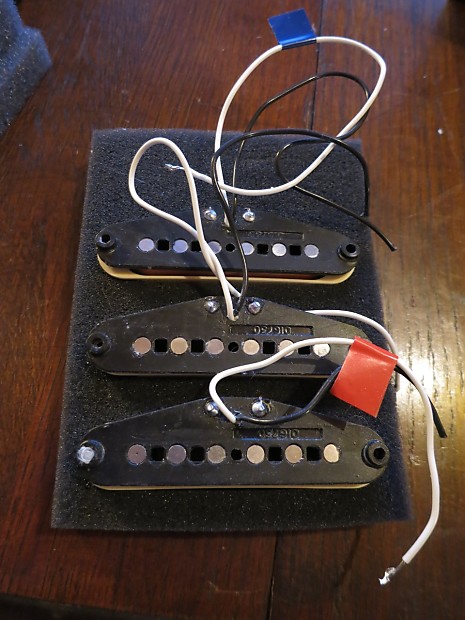
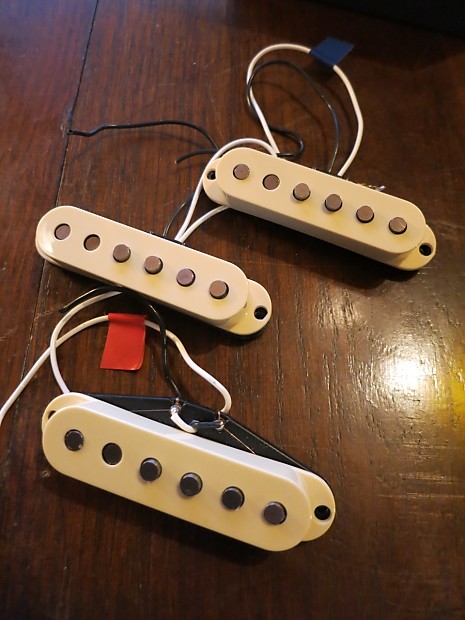
LATER HIGHWAY ONE PICKUPS after 2005-2006
(roughly 2005 on till the AM Special came out in 2011)
Some later Highway 1 Strats have number on them 72706, 72707, 72078 then came later in the 2000’s and the DCR was crazy high and can have a wide tolerance range (about 1.5K variation). Very unusual for AM stock pickups. These are ANICO 3. ALSO they are NOT Staggered. Further, they have colored wires on the as shown below. Not vintage tones at all.
- DCR: Lots of variance of DCR, from about 10.6K to 12.1K
- Center pickup has Red and Black
- Normal start and finish (black is start and “ground”)
- Stagger: No
- Magnet: Alnico 3
One of them: Neck – 11.13k Middle – 12.13kBridge – 12.01k
Another one: Neck 10.6 K, Middle 11.7 K, Bridge 11.7 K
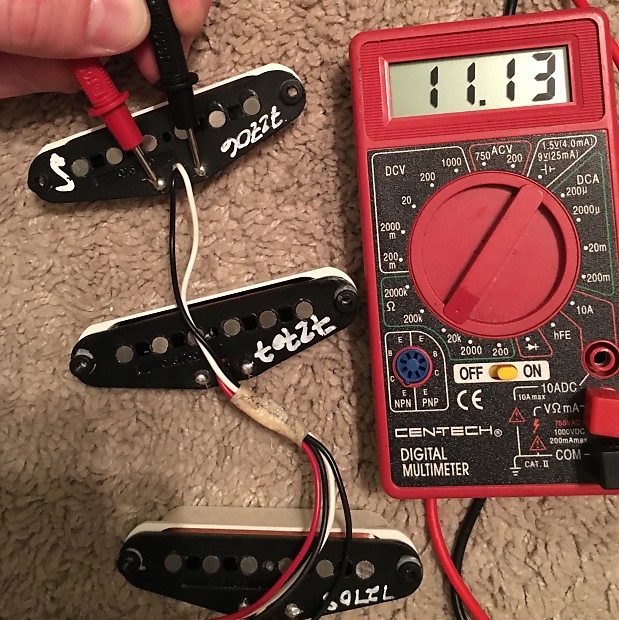
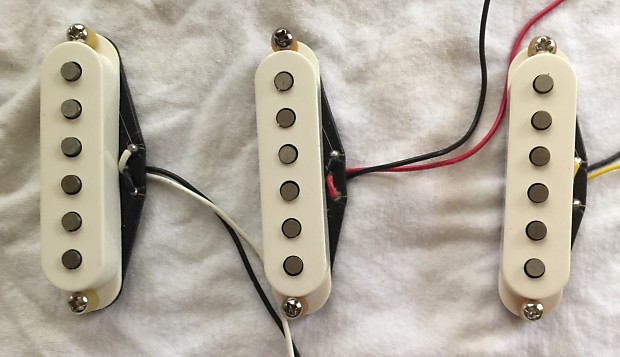
YOSEMITE – Performer
These were released on the original Performer Stratocasters. They are unusual in that the use Anico II and Alnico 4. They were kind of a first run for the “Tim Shaw” series. Slightly hotter as you move to the bridge. They have more variance between the position that some of the vintage series which use the same pickup for each position. These always read slightly higher than the advertised value. The change in the inductance is interesting, it means there quite a bit of Frequency peak resonance difference between the pickups.
These are also interesting because they start the linage where the pickup have different magnet material based on position.
- Wires: Neck (Black White), Middle (Yellow Black) Reverse Wound, Bridge (Red Black)
- Availability: Available NOS
- Middle RWRP:Yes
- Measurements (inductance measured at 120Hz
- New Set 1 (confirmed)
- Bridge: 9K — 3.36H – alnico 2
- Middle: 8.55K — 2.95H – alnico 4
- Neck: 8.02K — 2.57H – alnico 4
- New Set 1 (confirmed)
Fender Information:
- Wire: Plain enamel-coated wire
- RWRP: Reverse-wound/reverse-polarity (RWRP) middle pickup
- Bevel: No
- Stagger: Flat-magnet height stagger
- DCR/Magnet Type: (Fender Retail)
- Bridge: 8.9KΩ/alnico 2/3.21H
- Middle: 8.5KΩ/alnico 4/3.53H
- Neck: 7.8KΩ/alnico 4/ 3.86H
- Includes installation hardware
- Color of cover: Typically White

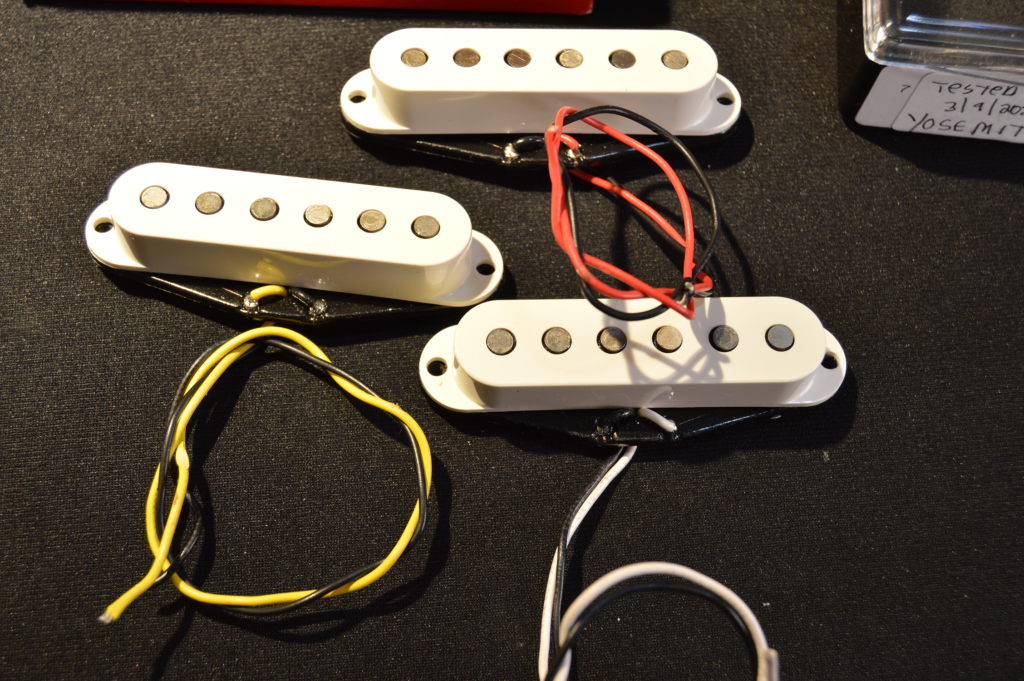
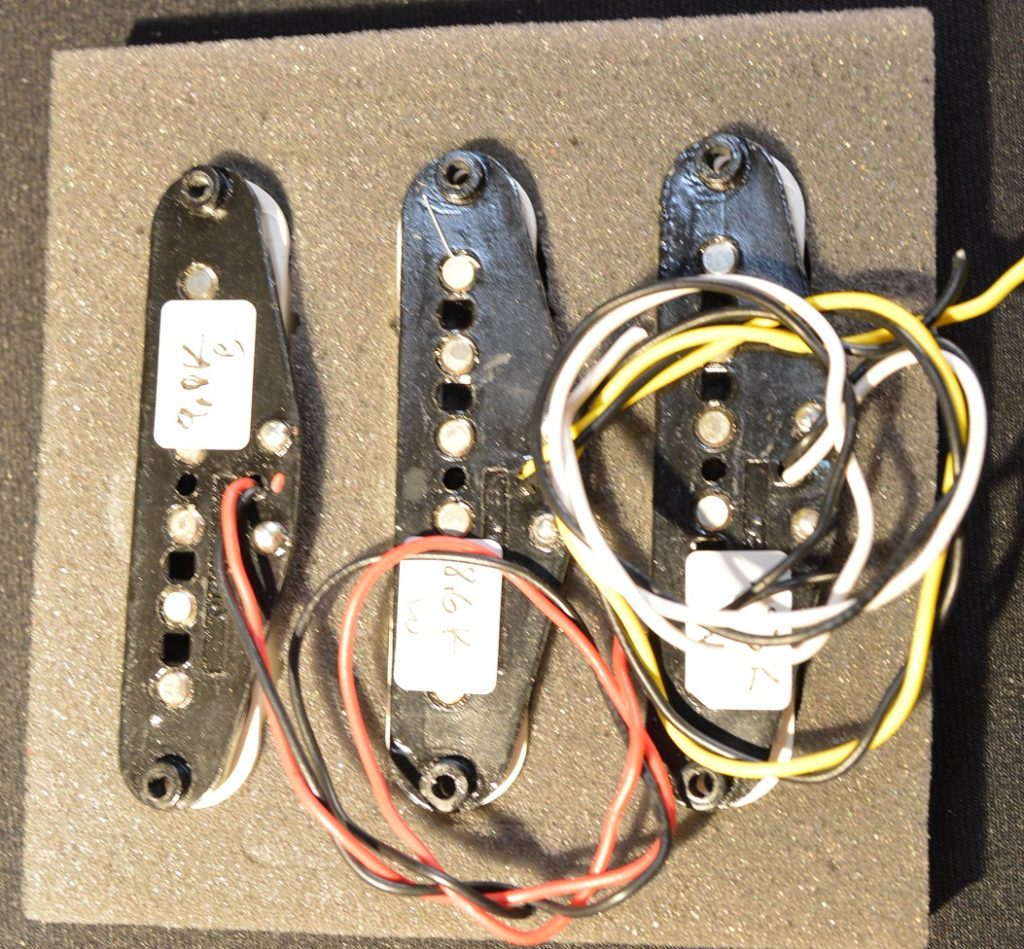
V-MOD – Professional I
V-MOD pickups are Tim Shaw designed (you know him right? oh, well anyway) they were released on the first PROFESSIONAL I Stratocaster. These are actually really good pickups maybe not as good as the later V-Mod II version.
They do use different magnets for different positions just like the Noiseless N3 models do.
Personal comments: As you move toward the bridge the pickup get brighter (not just because of the position) because of the pickup profile and frequency response. Plus the magnet pole material changes
Identifying marks: Red lines through the different poles on the bottom – Not on later models.
Inductance Note: I am measured at 120Hz when pickups are available using a higher quality meter. I have NO idea what frequency Fender is measured at but 120Hz is typical but they values do not match very well.
VISUAL: The difference between V-Mod I and V-Mod II is the color of the bottom, that’s it.
- Magnet Materials Used:Alnico II, III, V
- Model: American Professional I
- REAL MEASUREMENTS: 2024.04.06 – Inductance measured @120 Hz
- FENDER REFERENCE:
- Bridge:6.7K — 2.8H
- Middle: 6.7K — 2.74H
- Neck: 6.4K — 2.76H
- Measured Set 1:
- Bridge: 6.6K — 2.65H
- Middle: 6.2K — 2.60H
- Neck: 6.2K — 2.7H
- Measured Set 2:
- Bridge: 6.37K — 2.6H
- Middle: 6.34K — 2.65H
- Neck: 6.1K — 2.8H
- FENDER REFERENCE:
- Stock Covering: Aged White
- Manufacturer Part Number:0992266000
- Response: Neck (5,5,5) – Middle (5,5,6) – Bridge (5,5,7) – (Bass, Mid, Treble)
- Power Output: 3 out of 5
- Released On: Fender Professional I Stratocaster
- Available: NOS and Used
- Bevel: Yes
- Stagger: Yes
- Bottom Color: Black Bottom
- Magnet type per pickup: Neck: Alnico 3 and 2; Middle: Alnico 5 and 2, Bridge: Alnico 5 beveled, staggered
- RWRP Middle: Yes
- Polarity: Neck (South) – Middle (North) RWRP – Bridge (South)
- Return (Hot) Wire Colors: (Bridge) Red – (Middle) – Blue – (Neck) – White
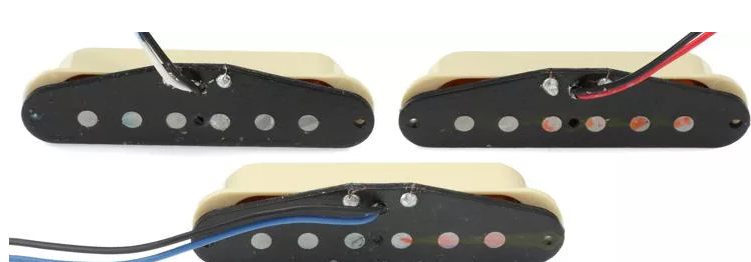
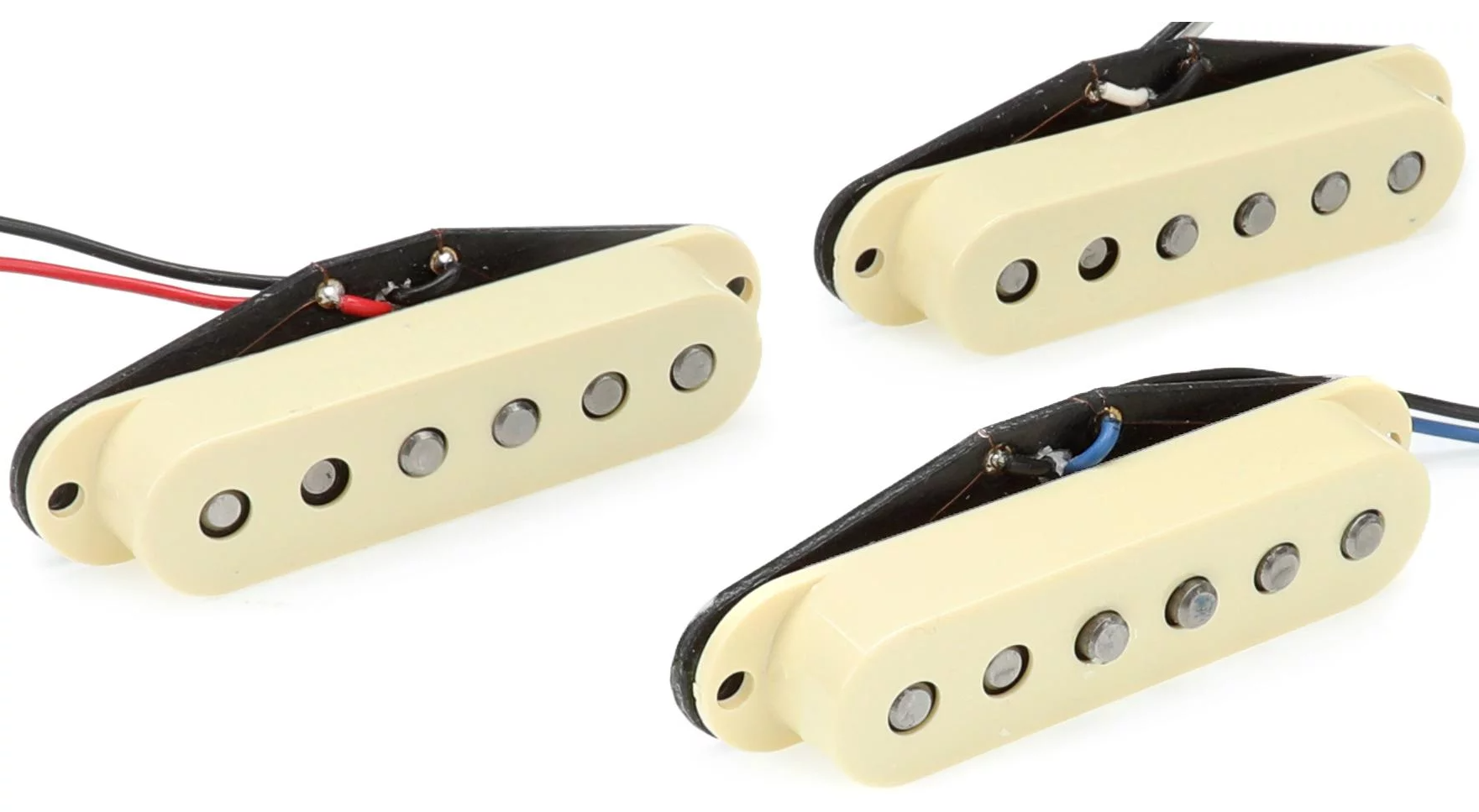
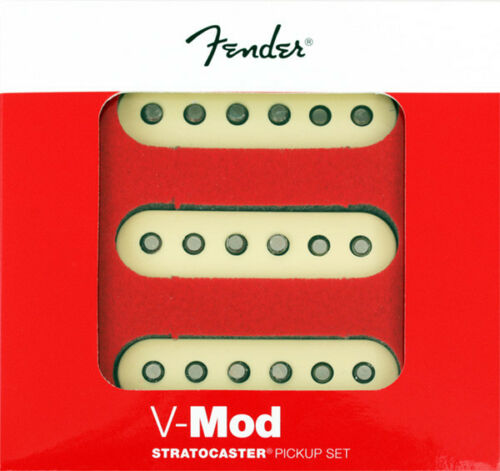
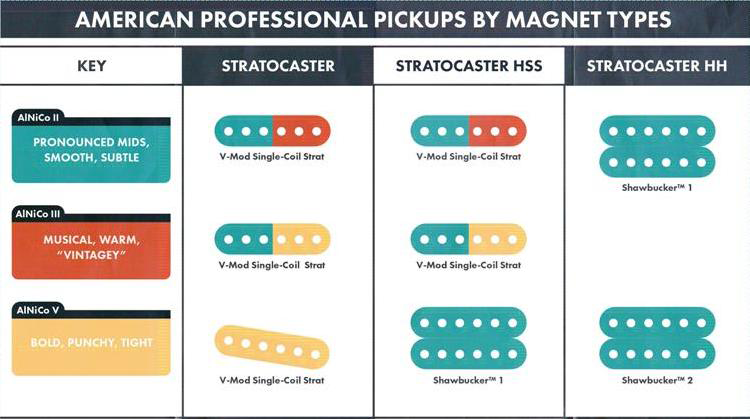
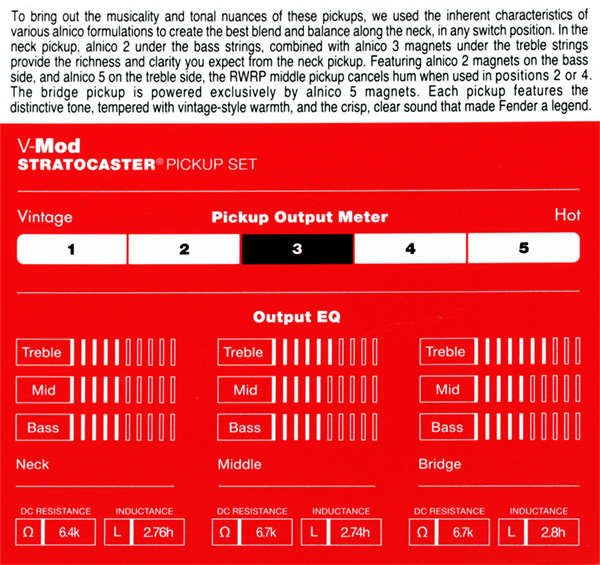
V-MOD II – Professional II
Updated: 2024.04.06 – I removed old measurements and added a new one with new better meter.
I recently obtained a couple of sets of these and they seem pretty decent. Overall I give them a 2 thumbs up!! The Bridge isn’t quite as bright as the V-Mod. I don’t have an Output EQ from Fender however.
What’s different than the V-MOD? Because I was unable to obtain a retail package (they aren’t available yet?) This is all based on measurements and what little detail I could get. According to Fender these are revoiced V-Mod which means, same magnet material the winding have changed a little. A LITTLE seems to be keyword here.
Once again, a 2nd child of Tim Shaw (of Styx Fame) for Fender. They Fender rep said these were modified to make them more in line with what Tim Shaw wanted.
Visual differences between V-MOD I and V-MOD II: Color of the bottom, that’s it. They only way to tell them apart is by measuring them.
- Model: V-Mod II Stratocaster single-coil pickups
- Official Spec: None Available
- HSS Humbucker: Double Tap bridge pickup on HSS versions
- Model appeared on: Fender Professional II Stratocaster
- Values (don’t have fender values on these yet) – All inductances measured at 120Hz – Very little change from V-Mod I
- Measured Set 1
- Bridge: 6.6K — 2.6H
- Middle: 6.2K — 2.75H
- Neck: 6K — 2.75H
- Measured Set 2
- Bridge: 6.1K — 2.6H (seems high for DCR but inductance is correct, measurement is verified)
- Middle: 6.2K — 2.65H
- Neck: 6.05K — 2.71H
- Measured Set 1
- Bevel: Yes
- Stagger: Yes
- Mix of Magnetic Types: Alnico 2, 3 and 5 (neck to middle) – SEE V-MOD I – I can’t find supporting documentation on this but expect it to be the same as V-Mod I – Only the windings have changed.
- Color: Gray Bottoms
- No real distinguishing marks except the bottom of the poles have been market with a marker but not on all sets..
- Wire Colors: Neck (White/Black) – Middle (Blue/Black) – Bridge (Red/Black)
- Middle Pickup: RWRP
- Original Cover Color: Aged White or Black
- Magnet Polarity: Neck (south), Middle(North – RWRP), Bridge (South)
- Retail Package Available: NO only available used.
Notable difference between I and II versions
- BOTTOMS: V-Mod II is GRAY bottom
- DCR: Lower DCR K values than the V-Mod I which make them sound “more classic strat” sounding and less dark because it shifts the freq notch higher. The are also more balanced across the pickups.
- Public Opinion: These come in HIGHER on the classic chime scale so if you prefer that, these are the pickups for you. In general this are slightly more popular than the V-Mod I

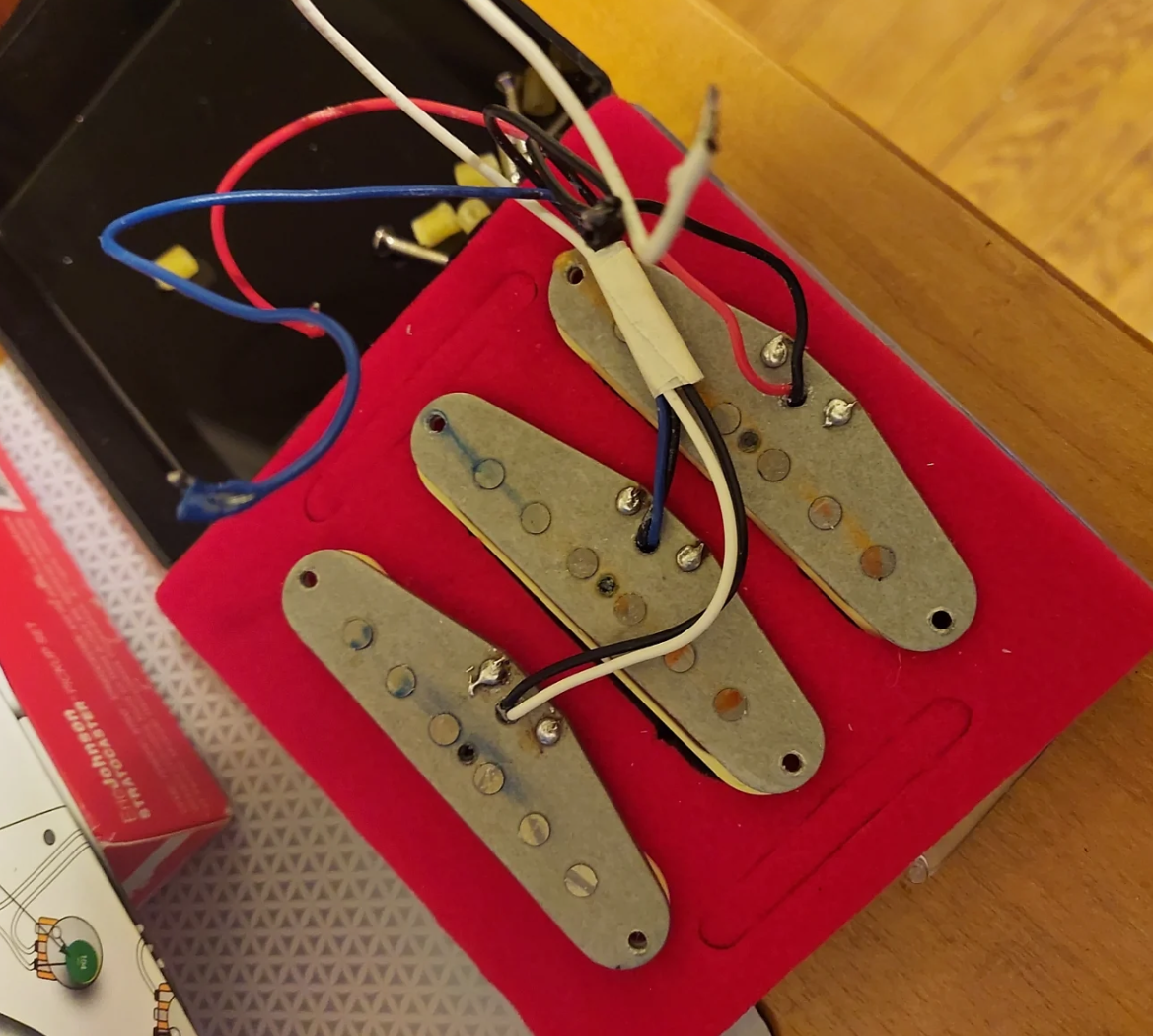
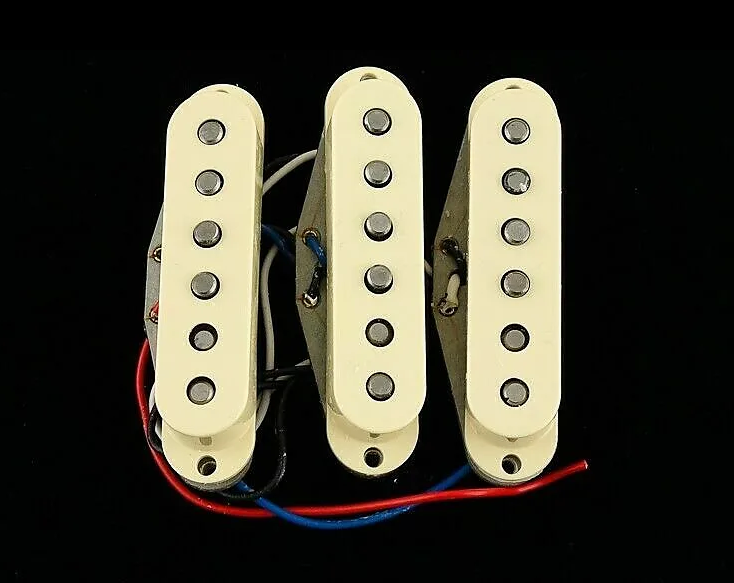
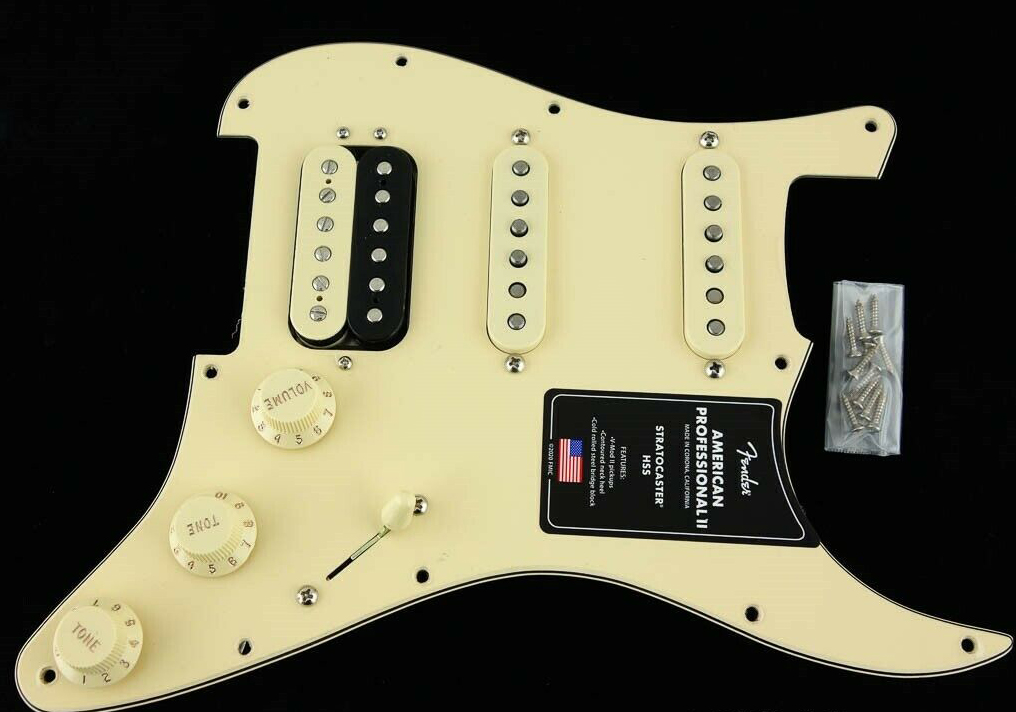
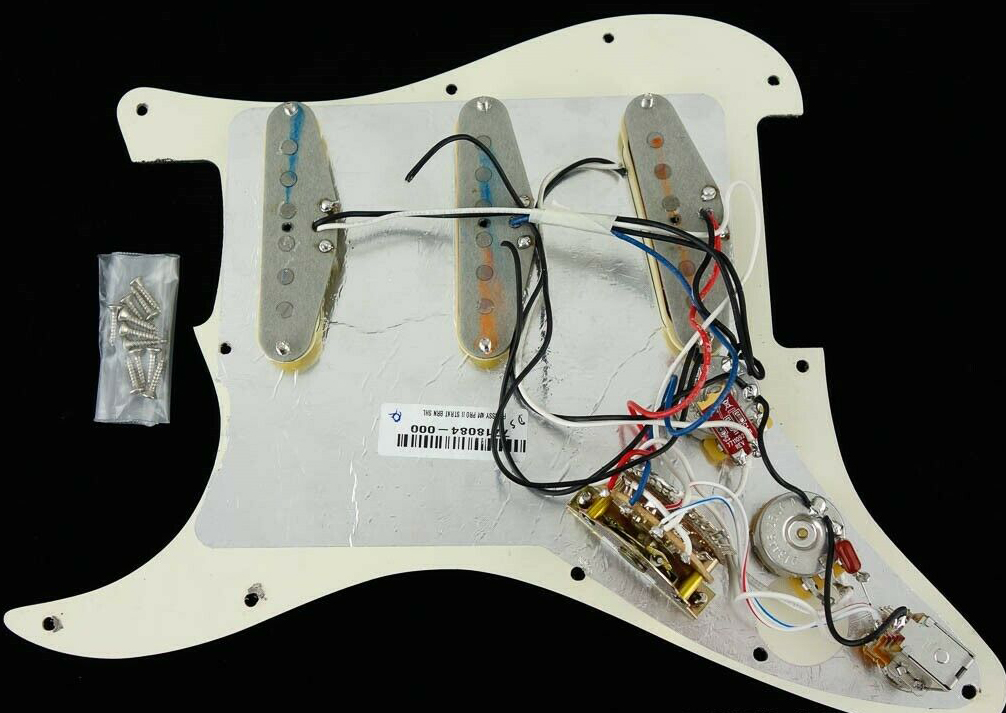
AMERICAN VINTAGE I
AMERICAN VINTAGE II – 57
Pickup are clearly marked with a 57 on them. They may have other marks
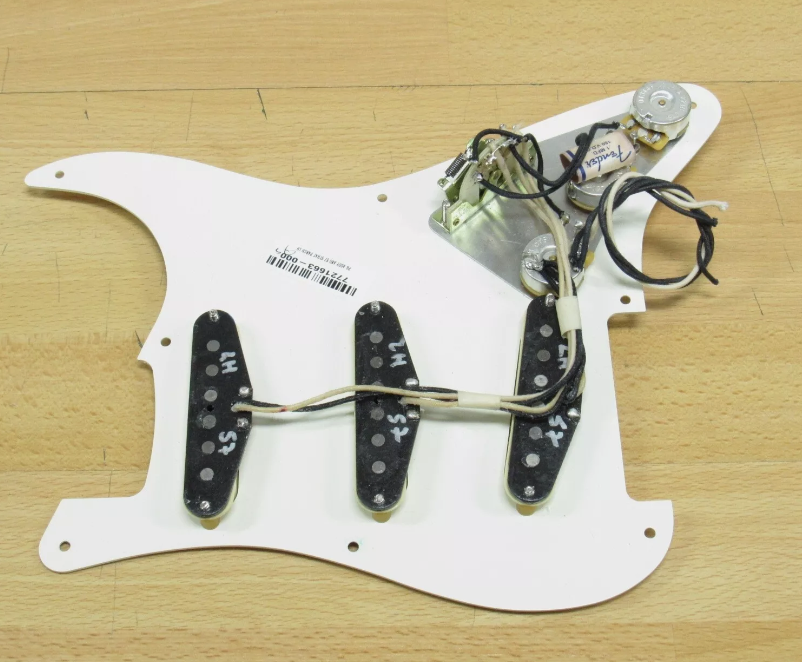
AMERICAN VINTAGE II 61
FEATURES
- Formvar coated magnet wire improves overall brightness
- Alnico 5 magnets add more focus and enhanced dynamics
- Staggered polepieces balance volume and output across every string
- Wax-potted
- Period-correct cloth wire and fiber bobbin construction
- Installation hardware included
Fender part# 0992389000 , 099-2389-000
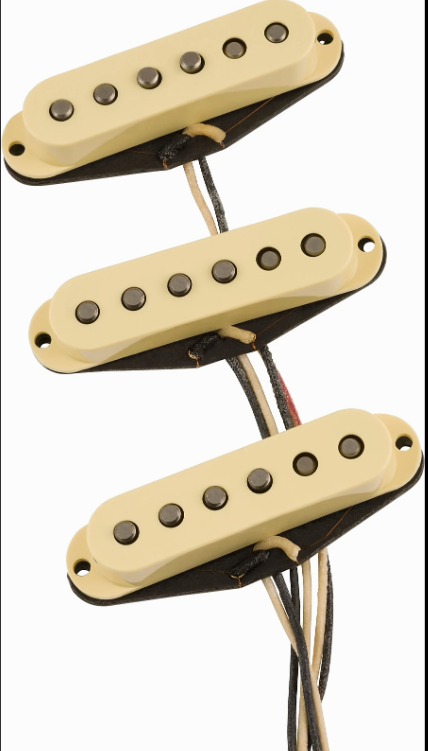
American Vintage II 73
No Measurements Available yet
- Anico 5
- RWRP Middle Pickup
- Gray Bottom
- marked with 73
- White (Finish) and Black (Start)
- Middle Pickup Yellow (Finish) and Black (Start)
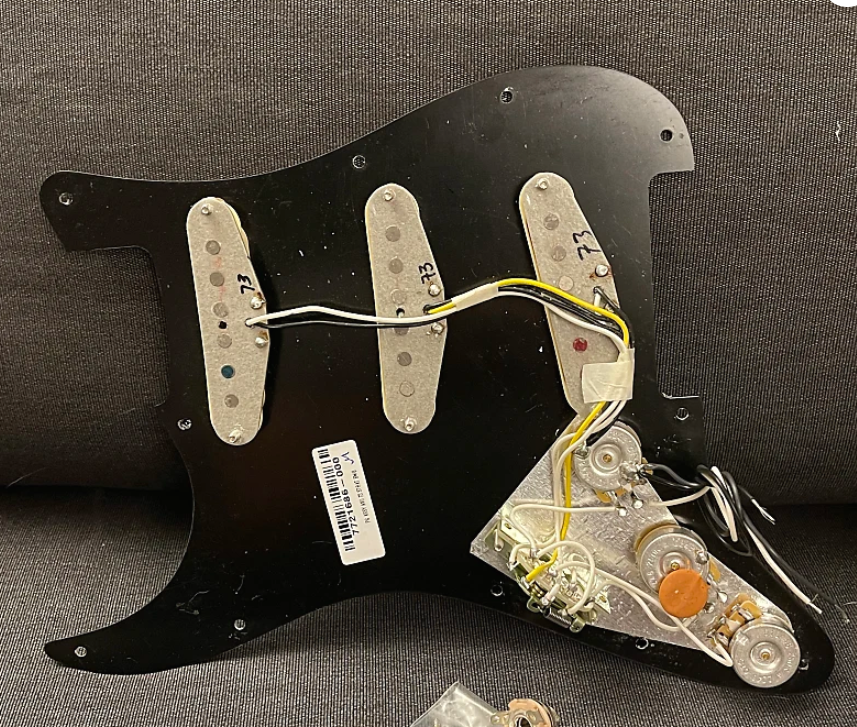
OTHER NOTES
Am. series or standards-plastic flatware. Mid 80’s and up (Standard NAMM intro 1987 TBX) to the delta tone, red middle pup wire, blue neck and bridge- whites to the switch.
